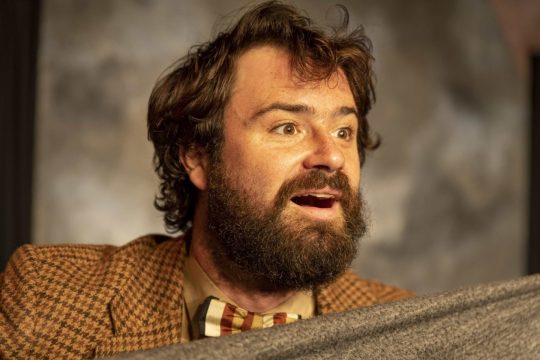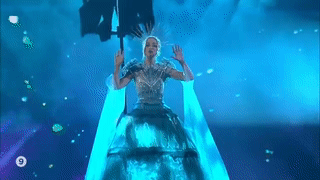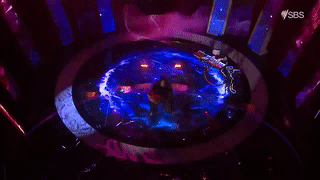#but it's starting to turn into pure flanderization in the OTHER direction
Explore tagged Tumblr posts
Text

I'm calling everyone out today.
#final fantasy vii#ffvii#final fantasy vii rebirth#ffvii rebirth#ff7#cloud strife#literal coolest thing ever#this fucking sucks actually#fallenchungus#meme#I get it#I get the appeal#I really do#you see through the MC's fake “cold distant merc” persona#you're exercising your media literacy skills so good for you#and nobody wants a one-dimensional edgelord for a protagonist in this game anyway#but it's starting to turn into pure flanderization in the OTHER direction#and that's just as boring#reducing a protagonist of this level of nuance and complexity to nothing more than pookie-posting gets old too#you've got the “deconstruction of the classic RPG hero” part of the story but left out the reconstructive part at the end#let's try for something a little more interesting than that from time to time shall we?#that's it that's the rant#enjoy your day
9 notes
·
View notes
Text
Collection Report: McMenamins Brewery Collection, 1983-2015

Oh my gosh, this collection has been in my backlog for YEARS! It has been so long that when my daughter helped with the inventory on the brew sheets she was 11 years-old and couldn't check herself out of summer camp [now she can drive and has taken the SAT], but she could talk with John Richen (brewing manager at the time) about her favorite beer names and things she'd noticed about ingredients.
Go straight to the guide: http://bit.ly/mss_mcmenamins
Learn more about the Oregon brewing industry in my Oregon Encyclopedia article
The McMenamins Brewery Collection is, truly, a gem. We scanned thousands of brew sheets, which is a part of the magic, but I'm also delighted by all the fun ephemera, including a full run of their coasters. I'll also add that the company biography included in this guide is really a love letter to the company, and I thank Fred Eckhardt, John Foyston, and all the other journalists over the past 30 years for recording all the fun quirks about this company.
SUMMARY McMenamins is a family-owned chain of brewpubs, breweries, historic hotels, and theater pubs in the Pacific Northwest.
The McMenamins Brewery Collection includes digitized brew sheets, digital images, brochures, coasters, decals, event programs, flyers, newspaper clippings, tap handles, posters, labels, a wooden cask, and a six-pack of Hammerhead beer.
COMPANY BIO

McMenamins is a family-owned chain of brewpubs, breweries, historic hotels, and theater pubs in the Pacific Northwest. It was founded by brothers Mike and Brian McMenamin, who grew up in Northeast Portland. In 2021, they operated 56 properties, with twelve hotels; dozens of breweries, pubs, and restaurants; movie theaters; spas; music venues; and a coffee roaster, winery, cidery and distillery. Many locations are rehabilitated historical buildings and at least nine are on the National Register of Historic Places. McMenamins only sells its beer in its own pubs, restaurants, hotels, and movie theaters.
Early businesses
Mike and Brian McMenamin both graduated from Oregon State University, Mike with a Political Science degree (1974) and Brian with a Business degree (1980). Mike and two college friends purchased the Produce Row Café, a bar known for all-night, high-stakes poker games, in Portland's warehouse district in 1974 and sold more than 100 types of beer. The building was built in 1951 and opened as a breakfast café for produce dockworkers in 1953; in later years, it was a barbershop. Mike and Brian bought Bogart's Joint, another Portland-area pub on 14th and Flanders. At various points in history, many beer-related activities occurred in this building: Kurt and Rob Widmer brewed in this location, and it was later space occupied by Portland Brewing and Rogue Ales Public House. By 1980, they'd sold Produce Row, Bogart's Joint, and a third tavern, the Stockyard Café.
Mike opened a wine distributorship and Brian opened the McMenamins Pub in Hillsboro. By 1983, Mike’s distributorship had failed, and the brothers decided to try the bar business again. Rather than the smoky, male-dominated taverns common in Portland, they were inspired by the community hubs they’d seen in Europe. They bought the Fat Little Rooster tavern on Southeast Hawthorne and renamed it the Barley Mill Pub; in addition to a varied beer selection, the pub was known for Grateful Dead memorabilia and anniversary parties. The namesake “barley mill,” which can still be found onsite, was used by Chuck Coury at Cartwright Brewing Co., Portland’s first post-Prohibition brewery. It was originally a kitty litter grinder but is now used annually to grind the grain for anniversary ales.
One major event that impacted the trajectory of the beer industry in Oregon in the 1980s was legislation that married production and sales. Fred Bowman and Art Larrance (Portland Brewing), Dick and Nancy Ponzis (BridgePort Brewing) and their brewer Karl Ockert, Kurt and Rob Widmer (Widmer Brothers Brewing), and the McMenamins lobbied to legalize on-site sales. On July 13, 1985, Governor Vic Atiyeh signed Senate Bill 813, the “Brewpub Bill,” into law. It allowed brewers to make and sell beer on the same premises, key for increasing revenue and gaining new customers.
First brewpubs
The McMenamins took advantage of the new law, and by the early 1990s had opened several brewpubs, each with its own small brewing system attached. They opened the Hillsdale Brewery and Public House October 31, 1985 in the Southwest Portland neighborhood of Hillsdale. Not only was it their first brewery, it was also the first brewpub in Oregon since Prohibition. Known as “Captain Neon's Fermentation Chamber,” a nod to Mike McMenamin’s nickname, the first several batches of beer were brewed with old Tillamook dairy equipment. On October 25, 1985, Hillsdale's first brewer Ron Wolf, who had previously worked at Anchor Steam, brewed the first beer in a small copper kettle and called it "Hillsdale Ale.” It fell loosely into the “Special Bitter” classification of beer styles and was a malt extract brew. Hillsdale Ale was brewed 29 times at the Hillsdale location and 14 times at Cornelius Pass Roadhouse between 10/25/1985 and 11/28/1986. In the first year, several brewers moved through the facility and made Hillsdale Ale, including Ron Wolf (who only brewed 13 batches before leaving), Conrad Santos (who replaced Wolf as brew master), Mike McMenamin, Brian McMenamin, John Harris, Scott Barrow, and Alex Farnham (the company’s first female brewer).
In 1986, they purchased a 125-year-old farmhouse in Hillsboro, Oregon, and turned it into the Cornelius Pass Roadhouse. Later that same year, they opened the Lighthouse Brewpub in Lincoln City. The Fulton Pub and Brewery opened in Portland in June 1988 and the Highland Pub and Brewery opened in Gresham in July 1988.
Eventually, 27 breweries would operate under the McMenamins umbrella and they became a training ground for new brewers, many of whom have gone on to found breweries of their own. Alumni include John Harris (Hillsdale, Cornelius Pass Roadhouse), Jack Harris (Cornelius Pass Roadhouse, Lighthouse Brewery), Jason McAdam (Edgefield, Hillsdale, Crystal Ballroom), Alex McGaw (Fulton, Crystal Ballroom), Ben Nehrling and Kevin Lee (Edgefield, Highland, Kennedy School), and Mark Goodwin (Old Church, Crystal Ballroom).
In addition to serving beer at their brewpubs, the company also hosted festivals, concerts, and other public programming events at their properties, including Dad Watson’s Brew Fest, Edgefield Brew Fest, Highland Pub and Brewery Eurofest, Hillsdale Brew Fest, Lighthouse Brew Fest, Mid-Valley Brew Fest, and the Thompson Barley Cup.
Beer and Other Beverages
The McMenamins’ beers could be unsettling to brewing traditionalists; they used ingredients like apples, spices, and candy bars, as well as lesser used malts like Chocolate and Crystal. They introduced fruit beers to Oregon and early batches featured blackberries from the Hillsdale brewpub parking lot. Hand in hand with their experimentation, McMenamins developed three core beers that are brewed at all their breweries. Terminator Stout (1985) is a dark, English-style brew; Ruby (1986) is a light, raspberry-flavored beer; and Hammer Head (1986) is a classic Northwest Pale Ale. Ruby and Hammerhead are iconic company characters as well; artist Lyle Hehn created Ruby Witch and Hammerhead, and both are staples of murals, posters, and coasters.
Terminator Stout made its debut in 1985 at the Hillsdale Brewery & Public House as the 12th beer brewed. Old Hammerhead, as the strong ale was first called, was brewed January 25, 1986 and was the 37th brew and made with malt extract. John Harris, who later created Mirror Pond for Deschutes Brewery, was the first to make Hammerhead an “all-grain” beer. Harris was hired in 1987, and when they transitioned away from extract brewing, he decided to rewrite the Hammerhead recipe; besides changed the grain, he also added more hops. Ruby, originally called “Ruby Tuesday” before the food chain objected, was first brewed in 1986 and used 42 pounds of pureed Oregon raspberries.
The company made more than beer. They planted 3 acres of Pinot Gris fruit in 1990 and looked to regional vineyards for additional grapes; McMenamins Edgefield Winery was established in 1992 and began by making Rhone-style wines, including grenache and viognier. The Edgefield Winery produces 20 different white, rosé, dessert, and sparkling wines and supplies 350 tons of wine to McMenamins pubs. Also in 1992, and predating the boom by more than 20 years, McMenamins started making cider at the winery and in 2018 sold as much cider by volume as wine.
In 1995, they began experiments with distillation and made brandy under contract by Carneros Alembic, a California distillery owned by Remy-Martin. In 1997, they built their first distillery in an old root vegetable storage barn on the Edgefield property. Their most popular whiskey is Hogshead, but they make several others, including Money Puzzle, which is dry hopped with Teamaker hops (which has 0 IBUs) and is sweetened with blackberry honey harvest from hives on their property.
Historic preservation
The brothers’ love of historic structures directed business growth and community involvement, and preserving important historical buildings is integral to their business. When the McMenamins started, they couldn’t afford new construction, so they purchased old buildings, which came with stories. They employ a small staff of historians to research and document the history, and those are in turn incorporated into each property’s art, murals, menus, place names, and architectural details.
In 1987, the company opened its first theater, the Mission Theater Pub, in downtown Portland. The converted 1890s Swedish Tabernacle, a church-turned-union hall, was also the state's first theater pub. In 1991, McMenamins turned a 1927 art deco theater that was slated for demolition into a second pub and movie house. These businesses were significant and ushered in a new way to watch movies with beer and food.
In 1987, the brothers purchased Edgefield, which was built in 1911 and listed on the National Register of Historic Places. They paid $560,000 and invested another $2.5 million to transform the farm's 80-year-old buildings into a multi-utility complex. Edgefield was once the Multnomah County Poor Farm, a self-sufficient facility with a meatpacking plant, power station, large rooming house, and infirmary. When the remodeled Edgefield Manor opened in 1991, the meatpacking plant was a brewery, power station a pub with a movie theater, infirmary a winery, and rooming house a 100-room hotel. There was also a meeting space, catering operation, restaurant called the Black Rabbit, herb and flower gardens, four liquor and cigar bars, distillery, golf course, and amphitheater. One of the more outstanding features of Edgefield, and something that would become the McMenamins' signature, was the extensive art installations created by local artists. Art popped up in surprising places throughout the complex (on ceilings, exposed heating pipes, eaves, fuse boxes) and showed local subjects (former residents, Northwest Indians, 19th-century brewers, the Columbia River Gorge). Within a few years, the company had a set of 12 freelance artists ready to work on new property acquisitions. Edgefield brewery is still the company's largest property.
In 1997, they purchased the Crystal Ballroom in Portland, which had been vacant for 30 years, and filled it with murals depicting the building's history, a brewpub, and a bar. The building was famous for its swaying dance floor, which sat on ball bearings. The Crystal Hotel was built in 1911 and became a dance hall and concert facility that hosted national music acts. Around the same time, they partnered with the Portland Development Commission and invested $4.5 million to remodel the Kennedy Elementary School. What was once a boarded-up building was transformed into a 35-room multi-use hotel with an onsite brewery, restaurant and four bars, a movie theater, a jazz hall, cigar bar, and soaking pool.
In 1999, the McMenamins opened McMenamins Hotel Oregon in downtown McMinnville, Oregon. The building was listed in the National Register of Historic Places and had been a hotel since its first two stories were erected in 1905; five years later, two more floors were added. In 1932, the hotel was renamed Hotel Oregon. In addition to renovating guest rooms, the McMenamins renovation added two bars and an art gallery with old photographs and new paintings that showed the history of the hotel and McMinnville.
Many property renovations followed. In 2000, they opened the Grand Lodge in Forest Grove, Oregon, which was formerly a Masonic home built in 1922. In 2001, they opened the 27 room Olympic Club Hotel and Theater, which was an expansion of the McMenamins Olympic Club Pub in downtown Centralia, Washington. The original Oxford Hotel was built in 1908 and Olympic Club was built in 1913. In 2003, they reopened the Rock Creek Tavern in Hillsboro, Oregon, which they had purchased in 1995 when the original tavern burned down. In 2016, the Anderson School in Bothell, Washington opened. The original Anderson School was built in 1931 and opened in 1936. In April of 2018, McMenamins opened their latest project, the Kalama Harbor Lodge in Kalama, Washington. Other properties include the White Eagle Saloon & Hotel in Portland, which was built in 1905; Boon’s Treasury in Salem, built in the 1860s; and Old St. Francis School in Bend, which opened in 1936.
ARCHIVAL COLLECTION INFORMATION The brew sheets and some event materials were provided to the Special Collections & Archives Research Center in 2015 and 2016 for digitization. The original items have been retained by McMenamins.
In addition to the brewery activity and the various beers released by McMenamins, this collection also contains information on events organized by the company, such as homebrew competitions and festivals. The cask held in the collection was used at the Oak Hills Pub and is decorated with a pen drawing created by brewer Chris Haslett. The photographs show art installation, artists, and property renovation.
The brew sheets and some event materials were provided to the Special Collections & Archives Research Center in 2015 and 2016 for digitization. The original items were retained by McMenamins.
Physical and electronic records are available for use in the Special Collections and Archives Research Center reading room.
3 notes
·
View notes
Text
Helvetica Sails On At Elm Street Cultural Arts Village
By Ricky and Dana Young-Howze
Woodstock, Georgia
On May Thirteenth around three o'clock the play Helvetica by one of our dear friends Will Coleman was dead on arrival. It was yet another theatrical casualty of this global pandemic that has shuttered the doors of theaters everywhere from the Elm Street Cultural Arts Village in Woodstock, Georgia all the way to Broadway. The notice was one of the millions just like it that Dana and I had seen in our feed and our hearts had gone out to them. As reviewers we have felt helpless sitting on the sidelines for this whole thing. Then we saw a post by director Nicole Adkins that the show was not only not dead but going live on Thursday as a digitally streamed experience. So one message later and Dana and I were sitting on our bed with our cats doing our first theatre review from our homes!

Saying that Helvetica is the story of a writer of the same name isn't doing it justice. A "deconstructed" or "exploded" life is more fitting. Narrated by her favorite stuffed bear Myron this play takes you on a journey through Helvetica's younger years with her Mom and Dad to her adult life in a marriage gone wrong, to her final months battling cancer. But we never stay in one place too long as Myron deftly moves us from one time to another weaving the story together as if it's a tapestry. This is a play about stories and how they're born.
I've mainly known Nicole as a talented children's playwright and teacher. This is my first real encounter with her directing and I want to point out two strengths she has. When you watch this the first thing you'll notice in many scenes is that you don't notice her. When you sample the wares of a baker you're not tasting the individual ingredients you're tasting the confection and this is the case with her. Like with my South Jersey cohort I love the directors that put in the time and labor over their shows but like up North she's one of the few where you don't see her metaphorical hands on actors' shoulders gently nudging them or see their handiwork everywhere. You just see the amazing work as a whole! Nicole's second strength was grand stage pictures that reminded us of the depth of this story and its journey through time. There were a couple times like in Helvetica's funeral and the ballerina scene where I felt pacing suffered for that depth but that is being completely nitpicky.
One thing I envy about K. Willow Coleman are their characters. But in this play there are some characters that offer challenges to actors which rival the feats of Hercules.

Take Myron (played by Sean Haley) in which you have to be a stuffed bear that's not just a stuffed bear. If you stepped into this role thinking, "I'm just Helvetica's teddy bear" you've failed from the beginning. Haley seems to know that Myron is also Helvetica's avatar, the only person that she has loved one hundred percent, and the only person qualified to tell her story. But he still had to also be a bear and through Haley's performance I never forgot that even though he's not wearing a bear costume.

Now there's the impossible task of playing Helvetica. Helvetica is played by three actresses: Past Helvetica (Evie Sickbert), Present Helvetica (Molly Gilmartin), and Future Helvetica (Mary Wolfson). It would be very hard to play one of these people but then you have the added hardship of making your performance work in such a way that I don't see a "seam" in the actresses portrayal and they all blend into one character. I don't know how much (if at all) they planned for this but whatever they they did it worked. If they did this purely by accident they should take that secret to their graves.
First of all Miss Sickbert was my absolute favorite performer! The scene she has with Helvetica's father needs a maturity way beyond her years and it touched me to the core. At such a young age to be emoting with her eyes and face like that is so amazing. Gilmartin's performance played the perfect balance of reserved and passionate. I totally felt her character's feeling of being stuck and she drew this emotion out of me that just wanted to yell "just punch the dumb husband and sail away with Myron!" Wolfson's performance is what grounded me and I found myself calmed by her. Playing a writer is hard already because all of the conflict is inside the head yet Wolfson allowed that inner conflict to come outside and I could see her working through it. All three of these women came together to give us only one Helvetica and they deserve a riotous applause.

Then there are the characters that form a sort of a spine to the play because even when we don't see them we feel them. Father (played by Daniel Sickbert) and Mother (played by Riley Rawson) were two such characters. These were both people who needed to be powerful performers because we had to feel their effect on Helvetica's life long after they were gone. I think Sickbert's delivery rang with me more but he may have been "cheating" because he was talking to his real life daughter Evie most of the time (although from people I know who have done it acting with real life family can sometimes be harder). At first I thought Rawson's performance left something to be desired but then I saw her start to settle in and own it. Her last monologue in the play is one of my favorites of all time and she killed it. I just wished we could have had that energy the whole performance.

Big shout out to James Cogswell for giving me a Husband that I want to punch in the face. It's very hard to play a jackass and my hat is off to him for it.

Okay I was looking in the program for the almost five other talented actresses that were in this play but it turns out that they were all Amanda Lynn Simmons. This performer is not only a talented actress and ballet dancer but also a composer! I can't believe that I'm using the word "polymath" in a review but here I am giving it to her. There you go Miss Simmons making me pull out my SAT words.

Okay I want to talk to both set designer Brian Gamel and lighting designer Megan Johnson. Because of the very monochromatic gray color palette of the stage all I could think about was that we were inside Helvetica's brain (her "graymatter") and watching her story unfold in her mind. If that was your intention you're geniuses. If it wasn't let that be your biggest secret. The grays gave a great background for Johnson's vibrant purples and the muted blues and greens and browns of Cindy Flanders' costume design. Also Flanders deserves high praise for uniting all three Helveticas with the same color scheme but giving them all different styles and tastes. Whereas the trio of actresses played a unified character the clothing clued us into their different personalities.
Also a shout-out to sound designer Zach Roe and projection designer Beth Tate. These roles hardly ever get any love and they are the unsung heroes of the theatre.
A special shout-out to videography by David Thompson Technologies without whom this production would have stayed cancelled.
Don't tell Katie Coleman this but this play has stuck with Dana and me throughout the seven or so years since we first saw the staged reading at the Hollins Playwright's Lab. We have stayed up at night in bed talking (and arguing) about this play because we love it so much. It was very special for it to be our first review from quarantine. Also even in this digital age we still feel that need to be somewhere in person. We've had eyes and ears as a species way before we got phones and cameras so there is still a drive to get around the campfire as a tribe and let our hearts sync up as one to hear a good story. However in these times it's good to be reminded that technology can help us feel present with our loved ones even in times of uncertainty like this. Hence why I was able to do a review of play done in Georgia from my home in New Jersey written by a colleague from Chicago and directed by a professor I met in Virginia. This is what reminds me that Theatre is really about community and as long as the community still thrives theatre lives on. You now have a limited time to be a part of that global community. Follow the link below and watch this play yourself. After you watch it share it with a friend. Hurry fast because after May 10th it disappears!
2 notes
·
View notes
Text
ESC2019 Preshow: #23
23. AUSTRALIA Kate Miller-Heidke - “Zero Gravity” SemiFinal 1, #12
youtube
Hey You! It’s me again 💁♀️ Hey You! Stone in my shoe. 💁♀️
ENTRY ANALYSIS
After internally selecting 4 soulless DNA entries in a row, Australia finally opted to have fun for a change and hold a national selection. Four years of deliberately withholding pure unfiltered campiness resulted in four really good entries, one of which won, hooray!!! (Sadly the winning entry was the weakest of the four lol 🤦♀️ but small victories)
Taking the central stage for Australia is ~beautiful baroness of baroque opera~, Kate Miller-Heidke, whose glamitude calls back to the halcyon days of Queen Elina Nechayeva. Opera is where the comparisons end though. “Zero Gravity” is less a treatrise on Gay Culture, as it is AN ANTI-DEPRESSION ANTHEM ❤🧡💛💚💙💜 It’s so disarmingly light-hearted and whimsical, which makes it very enjoyable to sit through!
However, it is all too easy to turn songs which don’t take themselves too seriously into A Joke... which is precisely what the Australia Decides staging did. “Zero Gravity” is delicate and upbeat, so we dress KMH up like the Statue of Liberty and give her a dementor? Honey NO!! WTF are you doing???
but I did alol at this:

Fortunately, KMH spoiled that her entire staging will be overhauled, which is amazing... but it puts her in the same boat as Pænda: It turns her into a question mark. If I’m left with no choice other than rating her according to her NF performance, then... well, here she is. I hope the final version WILL elevate her to a higher level (perhaps literally - why not? just steal the staging from Lenna Kuurma’s Slingshot!!) because I do feel this has the potential to become my favourite Australian entry of all times if done right!!!
NF Corner
Like I said, I prefered precisely three songs to KMH. From least good to most glorious, I’ll start with DRAG RACE ALUM COURTNEY ACT:
youtube
lmfao she was actually kind of horrible but I only noticed this NOW because sweet baby jesus that act was ON FLEEK. It made me forget that the song is actually kind of lame lol (which is a good thing!!! ESC is all about covering up your various degrees of sucktitude with campness!!!).
Second on the list are ”””“Indie Pop”””” band Sheppard of SAY! GERNONIMO!! SAY!!! GERONOMOOOOO!! fame:
youtube
lol I forgotten how fucking orange he fucking looked girl, but it’s a cheerful song with appealing staging, so it would’ve been acceptable! For some reason, “On my way” hit the charts in Flanders (and nowhere else lmfao), and still receives regular airplay on the station Peter van de Veire (our commentator) works for... hmm. 🤔
However, NONE of them. NONE of them compare to the geyser of gaiety, the fountain of funacity, the mælstrøm of mirth that is ELECTRIC FUCKING FIELDS:
youtube
WE’RE NOT GONNA LIVE

WE’RE NOT GONNA LIIIIIIIIIIIVE

F O R E V E R

OH OW OHHHHHH OW OW OHHHHH

HAPPY 2000 AND WHATEVER *WHAI*
People (losers) claim that Electric Fields sucked and had no staging but fuck that noise! Three minutes of Zaachariaha doing #JustZaachariahaThings free of the confines of stage direction is ALL I EVER needed in my life and MORE:
From twirling around in endless layers of robes and shawls, to engaging in aborginal dancing to fucking RIPPING OFF HIS HEADSCARF AND FLAILING IT AROUND LIKE A WHIP, with a look of 100% pure nuclear intensity etched onto his wonderful face. 🙌 ZAACHARIAHA FIELDING IS MY RELIGION🙌 Easily, EASILY would’ve been my #1 had they been chosen (and WOULD have *deservedly* come top five in Tel Aviv!!!)
(and also the song is awesome and infinitely quotable. Not even the Millenial Monroe known as MARUV could decorate the world with more love)
But ~ain’t nothing holdin’ me down~ in supporting KMH instead, even if she beat three superior acts, as long as she makes it work. 😊
Qualification Odds: Borderline (Advantaged)
I *thought* KMH could NQ right after she won AD, but this Mickey woke up from his paranoid place and I think she’s sitting fairly safe in and outer space.
I am putting Aus in BL though just on the mere off-chance that Aus fuck up the staging (ie: turn KMH into an even bigger joke than before), because if they do they might proverbially (um as well as literally) fly out of the competition.
Buuuuut I don’t think they will :) especially now that the Capricious Choreo Catoblepas known as Sabo-Tage Baptiste has set her sights on juicier targets (she’s coming for you Malta, Switz and Cyprus 😈)
Projected Placement: 4th-12th in the semifinal. If she qualifies, 11th-15th in the Grand Final.

Link to the masterpost
#Eurovision#Eurovision Song Contest#Eurovision 2019#ESC2019#Australia#Kate Miller-Heidke#Zero Gavity
13 notes
·
View notes
Text
https://sokumotanaka.tumblr.com/post/174162891984/makas-character-vs-rubys-lack-of-it
I barely know much about Soul Eater...and yet even I knew you’re full of shit
Sad thing is: you’re making SOUL EATER look bad, not RWBY.
“I struggled what to call this hell what to even talk about given ruby’s lacking characterization.
In this waste of post I want to talk about how miles in unfair to soul eater by ignoring maka’s character and point on the already known lacking bits of ruby’s.“
Spoiler alert: He’s gonna be FAR more unfair to both parties but especially Maka.
Now if you’re not familiar with soul eater I suggest watching the anime then reading the manga do to it branching off from the anime (But I say do both cause you’ll miss some amazing voice acting, animation and music from skipping the anime.)
Seriously? You are gonna argue Maka Albarn’s character...by recommending the ANIME?
The same anime that COMPLETELY fucked over Maka’s character into being an unlikeable, obnoxious bitch who randomly assaults male characters for showing attraction to female characters as well as being irrational about her father to the point that she has to be FORCED to spend time with a man who literally revolves his life around her?
See, this kind of paints a bad picture of you Soku: YOU SOUND LIKE A SOUL EATER STAN. You sound like you are so blind with admiration for the series that it can do no wrong in your eyes, despite the fact that the anime fucked over Maka by flanderizing aspects of her character to the point of making her unlikeable (believe me, I tried my DAMNDEST to like Maka in the anime) and making a DEUS EX MACHINA ENDING. No amount of animation, voice acting and music can salvage something like these two.
Maka’s a scythe master, a cheerful young girl she’s direct, she loves books to the point of having to be dragged outside by friends and she’s a brilliant strategist. I love maka cause she’s very hardworking as we would see evident to both media she’s from she’s constantly striving to reach goals better fighters can get to on pure strength and shows that a strong mind can overcome a stronger fighter.
And the best part is we’re shown her reading books, she’s often reading something that catches her interest or studying to better herself. (It’s even a plot point when needed to learn more about a scholar and powerful fighter from the past.) Although she’s now without her flaws, she grows past them to work alongside her friends even if certain one’s can try her patience.
Funny how you don’t mention these flaws and just gloss over them. Almost as though you feel insecure about Maka.
Let me inform everyone about Maka’s flaws: She’s irrational. She hates her dad for cheating on her mom which is understandable...to an extent. Thing is, her dad Soul REVOLVES HIS LIFE AROUND HER. He makes it constantly clear that he loves Maka with all his heart and soul and is constantly CRUSHED by her rejections. It’s said that Maka does this because she fears rejection but if that were the case then why would she subject her own father to that?
Not only that, Maka has a SEVERE tendency to assault male characters for acting perverted. Like, I know this is a thing in anime but with the way the she acts, you’d think she’s assault Mineta or Master Roshi, not guys casually remarking about people’s attractiveness. In fact, Maka’s pretty tempermental as well, attacking a lot of people who annoy her. Not to mention how she doesn’t read to better herself, she does it because she’s competitive and insecure, to the point it fucks with her in battles and in school. And for a few these (like her issues with her father): She never gets over.
Which is FINE. It’s her character. Not this Mary Sue cardboard cut out you made. The Maka YOU described sounds boring, unrelatable and fucking bad.
Now let’s go over Ruby
Despite ruby’s quick deterioration as a character she did have some characteristics to her in the past, in volume 1 she was afraid to branch out and used her sister as a security blanket, she had a fondness for weapons but it has dropped for a while then only brought up once, she was optimistic to a fault as that was the only trait she has as we continued, and she also likes books but mentioned it once and we’ve yet to see her bring it up again.
Gah! see this is me genuinely trying to like ruby as a character but sadly she’s not got as much to offer as maka does. Ruby as does many other character in rwby start deconstructing as characters as the series continues, I can’t remember the last time ruby did something smart enough for anyone to consider her a strategist (I mean I guess shooting nora was smart but you could accomplish the same thing by giving her electric dust, and the plan falters when you all smile tipping the villian off.)
yeah yeah, misrepresenting RWBY because you’re so insecure you feel a need to manipulate info.
Ruby is socially awkward. This shows numerous times throughout the series from not wanting to go to Beacon due to hwo weird she’d look there to being unable to communicate with Weiss properly due to her missing out on sarcasm and freezing up to her inability to talk things out with Weiss to her awkwardness at the dance to even meeting Winter. Look I listed like five examples.
Ruby is also heroic to a fault, rushing in against opponents without thinking as well as prioritizing others above her self. She attacked the Nevermore without thinking. She went after Cinder by herself without reinforcements. She goes up against the Nevermore in Volume 3 without thinking. She bottles up her emotions like in volumes 4 and 5.
Ruby is also flexible in her beliefs as seen in volumes 4 and 5 where she acknowledges she was wrong about how she viewed the world but still kept her beliefs by adjusting them to how her worldview has changed.
She’s inspiring as shown in how people tend to follow her example, like Jaune did in Jaunedice. Or how Blake’s view of things changed to be more like Ruby’s Or how she literally caused the events of Volumes 4 and 5 by being unwilling to let things go in Volume 3, inspiring JNR to follow her.
She’s also kind and trusting, like how she never tries to kill her opponents as well as trying to get Raven on her side in Volume 5.
And she’s gotten a will that would match up with a Gainax protagonist with how much shit she takes.
And even here you’re wrong because Ruby used the distraction of Blake’s arrival to send her best fighter to retrieve the Relic before the bad guy’s could!
Again, you sound insecure, like the moment you actually talk about Ruby she’ll outshine even your Mary Sue version of Maka so you jut shake your hand and avoid the topic.
It makes me think miles didn’t actually bother reading/watching soul eater and in terms of character hell in terms all around, fighter, character, positive female role model maka triumphs over ruby no doubt about it.
....
Maka can’t fight worth a shit without Soul and even then her feats, at ebst, are BARELY better than Ruby’s.
This Maka HAS no character aside from Mary Sue.
And this Maka has no flaws so why aspire to be her instead of the flawed but determined and kind Ruby?
Yeah, this is why I don’t want you to talk about Soul Eater and RWBY: You seem so insecure that you try to cover up Soul Eater’s ‘flaws’ but end up making it look worse. God I doubt YOU’VE read Soul Eater. I've shown a deeper knowledge of it and I barely have any first hand experience with it. Most of what I know is from friends and the wiki.
I made this cause wanted people whom know about soul eater and don’t to know the diservice miles did in writing it off instead of learning from it and using it to improve his story.
... this sentence makes no sense. Even I write better than this.
Best I can say here is: you never provide a link to the Soul Eater thing Miles said. And I don’t find it ANYWHERE. So I’m just gonna assume you lied.
And honestly Soku, You’ve done such a disservice to Soul Eater I think you turned people off it. You made their main character look like a damn Mary Sue and made it look so weak that it needs help beating fucking RWBY. I honestly believe you’re a misguided Soul Eater Stan.
Tune in next whenever when I talk about how one sided a ruby vs maka death battle would be.
Listen, nobody wants Maka to win more than me. Not because I like Soul Eater mind you but because I want Ben and Chad to get out of this scott free and I know you’ll assault them if they say otherwise.
HOWEVER I looked up Maka and Ruby on Vs. Battle Wiki...
http://vsbattles.wikia.com/wiki/Maka_Albarn
http://vsbattles.wikia.com/wiki/Ruby_Rose
... Yeah, Maka’s best feats are all reliant on the Black Blood Armor against Asura...which only WORKS with Asura or great amounts of Madness so it doesn’t work with Ruby.
So lets’ take the feats that actually work against normal people:
Maka:
Attack Potency: Building Level
Speed: Hypersonic+
Lifting Strength: Class 5
Striking Strength: Building level
Durability: Building Level
Stamina: Large
Ranga: Extended Melee, Several Meters with porjectiles
Intelligence: High
Ruby:
Attack Potency: Large Building
Speed: Hypersonic+ (WITHOUT her Semblance)
Lifting Strength: Class K
Striking Strength: Large Building
Durability: Large Building
Stamina: High
Range: Extended Melee, Several hundred Meters with Crescent Rose
Intelligence: High
... Yeah...
Things are NOT looking good for Maka. Her best powers only work against opponents in HER world while Ruby’s are so general that they can be applied universally.
I might be wrong here: I’m gonna read Soul Eater more after this to learn more but...even my friends who know Soul Eater say things are really close.
Just stop doing this Soku! You’re making SOUL EATER look bad!
24 notes
·
View notes
Text
'The ban on washing cars with tap water was just a foretaste'

Pieter Loose stood on the highest Alpine peaks, built a bamboo village in Brazil and took part in the World Rafting Championships in Bosnia. Now he shows off his water technology company Ekopak on the Brussels stock exchange. “Let us also try to become world champions in water recycling.”
Pieter Loose pulls his leg as he receives us. A muscle tear in the calf, the result of an hour of padel. These will be difficult weeks for the man in his thirties, without sports. "I'm a bit hyperkinetic. I need sports to recharge.'” He usually does that on the mountain bike. He covers 10,000 kilometres every year, with tours in Patagonia, Africa, Greece, the Dolomites. And sometimes rides of 5,000 altimeters per day. Suffering. “But for me this is pure holiday: crawling on my bike in the morning and just follow the GPS.”
Loose talks rather quietly and monotonously. Yet he is brimming with enthusiasm. "I've always had a big mouth and I've always been ambitious. But I never dared to think that my company would ever be listed on the stock exchange.” At the end of March, his water treatment company Ekopak[1], supported by main shareholder Marc Coucke, raised 50 million euros and it is now worth about 240 million euros. It is the temporary highlight in Loose's course. With Ekopak, he surfs along with water recycling technology on the realization that we are depleting our water reserves.
He paid "a few millions" for Ekopak. “It was a small, local company at the time, with a lot of knowledge. I put more ambition into it. The ball is rolling now. My dreams become reality. That gives me power.”
The company has been building container installations for many years to produce ultrapure water for chemical, pharmaceutical, textile and food companies, among others. “Compare it to a descaler for the city water in your home, to protect your taps. But we go much further." “For customers who produce high-pressure steam, the entire Mendeleev table has to be removed, otherwise those elements will affect the steam boilers,” explains Loose. “Every customer requires a different degree of purity. For cooling water, water to clean machines, water for chemical processes.”
While until recently Ekopak treated groundwater and drinking water, today - after thorough research - it starts from waste water at the companies themselves. “A technical challenge, but future-proof,” says Loose. In addition, he launched the WAAS (Water-as-a-Service) concept, whereby Ekopak not only builds installations, but also finances and operates them and invoices the customer per drop of water. This should result in unprecedented revenue and profit growth in the coming years. “We have turned a sustainable product into a sustainable business model.”
What is the driving force behind Ekopak's growth?
Loose: "Long ago, investments were made in a network to provide everyone with clean drinking water. Industrial companies have joined the same network. That was the most obvious solution. But the situation has become completely out of balance: factories today use billions of liters of drinking water per hour. This used water is subsequently treated in a biological water treatment plant to be discharged into streams and rivers. It flows to the sea and you lose it. Consequently we have to install desalination plants at the sea side that consume a lot of energy to pump the water inland again. That is not future-proof, and companies are increasingly interested in that.”
How serious are companies about this?
Loose: “Twenty years ago you had Greenpeace with a slogan like 'better a hole in my T-shirt than a hole in the ozone layer”. But that's where it stopped. Now a tipping point has been reached. Companies set themselves concrete targets for energy, CO2 and water use. This is important to attract investors, subsidies and staff. The dominoes are falling, and that's a good thing. Climate change is real.” “The water supply is under pressure. Companies are not only afraid of a blackout, but also of a blue out. We've already had a foretaste of bans on using tap water to wash cars and fill swimming pools, and bans for farmers on pumping water from streams and rivers in certain regions. Water has a value like oil. We never thought about that. But the awareness that there are limits is growing at a rapid pace. We feel that. We keeps us occupied.”
How bad is the water scarcity in Flanders?
Loose: "Very. There is plenty of rain, but because it is a densely populated and paved area, the rain disappears into the sewers instead of seeping into the ground. Moreover, we have an economy with water-intensive sectors: food, textiles, pharmaceuticals, chemicals. In the OECD ranking, we are at the very bottom for the amount of water available per person, behind southern countries such as Spain and Italy. That also offers opportunities. We are forced to find a solution: Belgium will educate the world when it comes to rational use of water. That creates companies like Ekopak. We also intend to score internationally with that knowledge.”
Is the industry the main culprit?
Loose: "I'm not saying that. There is also agriculture. And in families at home, only 10 percent of drinking water is used for drinking. We still flush our toilets en masse with drinking water instead of rainwater. But our focus is on industry, which uses a quarter of drinking water in the northern region of Belgium. If we could reduce that, we are taking a big step forward.”
What is the role of politics in the water problem?
Loose: “Everyone is aware of the issues. The Blue Deal of Flanders[2] proving it. Money is earmarked for buffer basins and more wet nature, or for reductions in leakage losses, and so on. Mandatory water audits are introduced at companies and linked to environmental and expansion permits and subsidies. It is being examined whether companies can inject any surplus of recycled drinking water into the network against payment. It wouldn't surprise me either that there will be a limit on applications for which you can use drinking water or groundwater in industry, comparable to measures for your swimming pool.”
How important is the IPO in the growth plan?
Loose: 'It is crucial to roll out the Water-as-a-Service strategy. We will not only build the small water factories at the customers' premises, but will also operate and pre-finance them. This requires money: from 100,000 to 10 million euros per installation, depending on the flow rate and quality. We invoice per drop for a period of ten years or longer. We decrease the customer’s worries. And while tap water is becoming more and more expensive, our price is 20 to 40 percent lower. We therefore also strengthen their competitiveness. That makes companies bend in our direction more quickly. In this way we can tackle the water problem at an accelerated pace.” “The IPO also generates more than just money. It gives you more body when negotiating long-term contracts with multinationals. We are now approaching them as a listed company, no longer as 'that SME from Tielt with a skilled CEO'.'
Do you already have customers for that new concept?
Loose: “Eight projects are up and running, among others at the chemical companies Eastman[3], the copper film producer Circuitfoil[4] in Luxembourg and the vegetable processor Darta[5]. An installation has been started up at the pharmaceutical company Takeda[6] in Lessines to reuse 600 million litres of waste water. That's the equivalent of 18,000 people's water use, which means all of Lessen. We actually connect an entire city to the water network in one go. I also see many small and good initiatives, such as trucks collecting construction site water. But what we realize is of a different order. We are going fast, and sustainability knows no bounds. We also go abroad. Takeda wants to roll out our technology in its factories worldwide.”
You have now lost control of Ekopak. Is that difficult?
Loose: "The opportunity we now have to move forward gives me more satisfaction than the idea of being one hundred percent owner of a small company from which you are not getting the most out of it."
Source
JAN DE SCHAMPHELAERE, Ekopak-topman Pieter Loose: 'Het verbod om auto's te wassen met leidingwater was slechts een voorsmaakje' in: De Tijd, 24-07-2021,
https://www.tijd.be/ondernemen/technologie/ekopak-topman-pieter-loose-het-verbod-om-auto-s-te-wassen-met-leidingwater-was-slechts-een-voorsmaakje/10321369.html
[1] https://ekopak.be/en/sustainability/ [2] With the Blue Deal, the Government of Flanders is increasing its efforts in the fight against water scarcity and drought. With this deal, it wants to tackle the drought problem in a structural way, with an increased deployment of resources and the correct instruments, with the involvement of industry and farmers as part of the solution and with a clear exemplary role for the Flemish regional and other governments in Belgium. The Flemish Decree on Integrated Water Policy is officially approved in July 2003 (Belgium Law Gazette, 14.11.03). This decree is the juridical implementation of the European Water Framework Directive and the Floods Directive in Flemish law. https://www.integraalwaterbeleid.be/en [3] Founded in 1920, Eastman is a global specialty materials company that produces a broad range of products found in items people use every day. With the purpose of enhancing the quality of life in a material way, Eastman works with customers to deliver innovative products and solutions while maintaining a commitment to safety and sustainability. The company's innovation-driven growth model takes advantage of world-class technology platforms, deep customer engagement, and differentiated application development to grow its leading positions in attractive end-markets such as transportation, building and construction, and consumables. As a globally inclusive and diverse company, Eastman employs approximately 14,500 people around the world and serves customers in more than 100 countries. The company had 2020 revenues of approximately $8.5 billion and is headquartered in Kingsport, Tennessee, USA. The chemical company has 2 plants in the Ghent harbor in Belgium. https://www.eastman.com/pages/home.aspx. [4] Circuitfoil develops; Produces and markets high-quality copper foil, while constantly ensuring a safe and healthy environment in its plants, processes and products. rom its corporate headquarters in Luxembourg, Europe, the company distributes and markets its large range of products through a wide network of service centers and sales companies to customers worldwide. https://www.circuitfoil.com/company/profile/ [5] d’Arta is a Belgian family company founded in 1988 that has grown into a global player in the development, processing and commercialisation of fresh frozen products such as vegetables, fruits, herbs and ready-made (side) dishes. It employs more than 900 people and export our products to more than 100 countries. https://www.darta.com/en [6] Takeda is one of the 10 largest pharmaceutical companies in Belgium. Takeda’s presence in Belgium is reinforced by its global manufacturing site in Lessines. This Takeda site has over 18,000 m² of building surface and operates 24 hours per day, 7 days per week. It is a flexible plant for purification and a packaging center for immunology and hematology products, covering a total geographical span of over 80 countries worldwide. In total, more than 1000 professionals work for Takeda in Belgium, making us a top 5 employer in the pharmaceutical industry. https://www.takeda.com/en-be/who-we-are/contact-us/
1 note
·
View note
Text
Dissertation prizes 2017
The winner of the dissertation prize 2017 is: Charlotte Stuby!The jury also awarded two laureates with an honorable mention: Gabri Molist Sancho and Manuel Penteado!At the proclamation their co-supervisors - Anja Veirman, Isolde Vanhee and Tom Van Imschoot - read a laudatio, that you can reread here ...
Charlotte Stuby - laudatio 'Creatures in reality' by Anja Veirman

Charlotte’s thesis reads like a travelogue from the ordinary to the fantastic, from the trivial to the fascinating. It’s a praise of everyday life where reality is never what it seems. It all started with floating textile elements in the landscape. Merely banal objects that drew Charlotte’s attention; like covers on plants, cars or motorcycles, fabrics on scaffoldings, or nets on vineyards. Charlotte analyses aspects of form, surface, functionality, tactility, plasticity and materiality, and she explores the notions of reality, ambiguity, and territoriality in a poetic and playful way. She draws us from observations, through personal experiences, a rich body of literature and phenomenological reflections into her aesthetics of the world. Hereby transposing these objects to another level: the level of mystery, reverie and an altered, enriched sensitive perception. The reader gets involved in Charlotte’s inquiries and lured into her surrealistic and sensitive interpretations.It’s truly an artist’s text, driven by perception and reflections in correspondence with the making process of her textile creations. In Charlottes artistic practice Making by thinking and Thinking by making go hand in hand, and this dialogue breaths through her written reflections. The thesis played a crucial and critical role in the development of her artwork, and Charlotte makes us part of her artistic research. We get an inside view in how her perceptions and thoughts are taking form. And that’s just one of the pleasures reading this thesis!Charlotte Stuby offers us a gift, a gift of reimagining and altering our own banalities by opening up our senses to another vision and experience of the world.


Gabri Molist Sancho - laudatio by Isolde Vanhee
Doomed is a comic book by Gabri Molist. Or isn’t it? Doomed is almost exclusively built on smart and witty dialogues. Can a comic exist, can it ‘be’ without images? And what happens when the author of a comic loses control over his creation, gets sucked into his own story and starts bickering with his characters? And what if that same author exposes himself as a troubled and lovesick writer, does that mean that the fiction has drifted into reality? Or is it the other way around? In Doomed, we follow two characters that question life, love, destiny, art and creation altogether. You can almost hear Gabri think (and laugh) out loud, with his characters, with the unruly nature of his comic, and ultimately with himself as the out-of-control creator. The more things get out of hand between the characters and their creator, the more complicated the existential questions that are being raised. Gabri Molist has made a comic where creating a comic and researching its existence are bound together. In the letter that accompanies his comic, Gabri addresses the reader and talks about all things, big and small, that challenge him as an author. He writes about the use of panels in comics, about the dialogue between fiction and reality, about the way humour shoots in all directions, but he also writes about soccer and his hometown Barcelona, comparing himself to Xavi Hernandez and stressing the importance of having the ball at all times. As a comic book writer, Gabri has balls. Doomed is one big gag, from start to finish, but, in the end, you are no longer sure on whom the joke is and who finally has the ball. What you do know is that funny dialogues can be serious business, that they can be disturbing, disruptive, dangerous even, for writers, their characters and their readers.


Manuel Penteado - laudatio by Tom Van Imschoot
All order turns into entropy, the second law of thermodynamics explains. So what does it mean then to make a living as an artist, that is to say: to devote your life to finding shapes amidst chaos? Suggested Permanence, the thesis of Manuel Penteado, looked for the elegance of a mathematical solution at first, the perfection of a circle. Yet it gradually dissolved into a cluster bomb of imperfect shapes and things that were collected, looked at, studied, and endlessly rearranged as an end in itself. Which is exactly the way all work of art begins. While reading one feels like entering a Wunderkammer, a space where the most curious shapes of our daily world are assembled in order to comprehend the “universal” laws that govern them. Yet, Manuel is not like a God looking for the very key of creation. He has too much a taste for decay and the humour of irregularity to understand that his artistic focus is more about questioning where creation begins and ends. Or about the ultimate freedom that stems from understanding the limits of what an artist is able to do, regarding for instance the simple yet mind-blowing beauty of what is only pure coincidence. Thus, a sculpture made by cows in West-Flanders gets connected to Einstein’s theory of relativity in this serious yet playful thesis. In-between both we see the artist changing from a painter and a sculptor into a collector of things that are exactly in-between, while his collection of shapes and time and emptiness and stories all of sudden turns into ‘the thing itself’. This is a wonderful example of how to turn the book of your thesis into an exhibition space for the recollection of a thought process, a process that is potentially endless if it weren’t for the need to make a work of art in the end, a finite shape endowed with the illusion of immortality. Seldom have I seen an all-encompassing ambition and a humourous sense of banality getting so fluidly intertwined in a master project as in this fun thesis that testifies to the never-ending work of the earnest, generous and, strangely enough, lazy Manuel Penteado.


photos © Koen Cant
3 notes
·
View notes
Text
The Forum, 1908
Page 113: The novel in its modern form is a conception of more unity of form and purpose than anything that the classic world conceived. Yet realism, in its fidelity to evil and good alike, to the little significant trifles as well as the momentous crises, was not an invention of Zola. It was already understood and applied with forceful irony in the ‘Satiroe’ of Petronius. The Beast Story, from its early literary development in the ‘Hitopadeça,’ down through ‘Aesop’ and La Fontaine to Kipling, is in the ‘Jungle Books’ different only in degree, but still essentially te same in kind. Indeed, the whole cycle of Mowgli stories are nearer in spirit to their Sanskrit prototypes than to the work of the great French fabulist. But whatever the type of fiction, whether realistic novel or picaresque romance or simple beast fable, the same general tendency is observable—a natural and logical tendency to keep pace with civilization, to become more careful of the truth, in proportion as the rating public becomes more sophisticated. And this increased respect for the truth on the part of the novelist is not a matter of ethics, but of self-preservation. Page 120: The structure of the story is of the simplest; ;but the style is ever possessed of a certain quaint charm, all the more grateful in these days of strenuous haste, because it is throughout so leisurely. The author seems never so pressed for time that he cannot digress in picaresque fashion, to weave in some extraneous tale, or stand and watch a well-contested fight, a hard-earned race. Indeed, the story is throughout subordinated to the panorama of life all the time unfolding in the background. Fanshawe himself is a not unworthy hero; but what interests you chiefly is the sense you get of having for the time being looked back upon the changing stream of human activity, as it swept along the highways and byways of rural England a century ago. But to be enjoyed, it is a book that must be read at leisure, and when you are in a congenial mood. Page 534: But, writing on the plan, Professor Chandler has turned out a very complete and admirable piece of synthetic work. His research has been so exhaustive that one is a little aghast at realizing the degree in which rascality in one form or another has been the theme of literary production. It is undoubtedly true that general histories of literature are deficient in their consideration of the picaresque output—especially the criminal biographies, the jest and beggar books, the conny-catching pamphlets, the prison tracts and repentances, and even the tramp and burglar literature of the present day. About all of these the author gives an amount of information that would be very difficult to gather elsewhere. ……. The real literature of roguery arose in Spain in the middle of the 16th century with the ‘Life of Lazarillo de Tormes.’ This celebrated character was introduced to the world in 1554, when the ear of Spanish decadence had already begun, and the ideals of chivalry were rapidly being given up. “The disdain for patient labor made room for easy cheating, and the lack of bread more and more enforced it.” The authorship of the epoch-making book is assigned on doubtful grounds to the poet-statesman, Diego Hurtado de Mendoza. Lazarillo is the prototype of the true picaro. He is “an anti-hero who makes his way in the world through the service of masters, satirizing their personal faults, as well as their trades and professions.” The picaresque narrative possesses “two poles of interest—one, the rogue and his tricks, the other the manner he pillories.” In its development the literature of roguery lost much of its original character. We soon find the rogue ascending the social scale; he becomes a person of family and a gallant adventurer—a master with a scheming valet of his own to continue the old tradition. For over a century the picaresque narrative had tremendous vogue in Spain. But the vein was finally worked out. Meanwhile the tradition had passed into France and by 1630 had been firmly implanted. Page 535: Le Sage’s masterpiece [Gil Blas, 1715] was the great distributer of picaresque influence and England felt its full effect. We go far back for picaresque origins in England—there is plenty of such material in the early Chronicles, plenty of roguery in Chaucer. Its literature was a powerful factor in forming the primitive drama, for which such legendary rascals as Robin Hood, Robin Goodfellow and Friar Rush were copious sources of supply. But in the creation of the 18th century novel foreign picaresque sources were plentifully drawn upon. The development of the novel, however, was so rapid and expansive that French and Spanish influences quickly disappeared. Daniel Defoe was the first to reject the chief characteristic of the true picaresque type—“the story for the story’s sake—independent of the conditions of actual life.” “The contrast between ‘The Fortunes and Misfortunes of the Famous Moll Flanders’ and early picaresque fiction,” says the author, “is remarkable. … Defoe at a blow changed a comic and satirical fiction to one, in a sense, of character. He showed the decline of a soul from innocence to knowledge, temptation and sin, and then its rise by virtue of repentance from distress through honesty to prosperity and calm. … He surpasses Le Sage in adhering to unity of character. … In ‘Moll Flanders,’ and to a less extent in ‘Colonel Jacque,’ Defoe has struck the keynote of the modern novel. He has partially subordinated incident to character.” From now on the picaresque element gradually waned. It had been useful, but fiction as a finer art had now no need for it as such. The libertinism of Richardson’s heroes bears no resemblance to the love affairs of the Spanish rogues. Fielding’s characters are never truly picaresque. Tom Jones is a “compromise between the picaro and the hero, intended by his creator to set forth humanity in the average.” Smollett did indeed take the traditional rogue as a model, but he rarely used him with success. Page 536: Sterne never drew a rogue. A new use of picaresque material was disclosed by William Godwin in ‘Things as They are, or the Adventures of Caleb Williams.’ This, as Professor Chandler explains it, is not a novel of intrigue, adventure or manners. “The attack upon social conditions and the study of character are its aims.” The influence of this book extended well into a later age, and served as a model for the reformative novels of Bulwer-Lytton. The picaresque factor in the creation of the modern novel is unquestionably important, for it is one of the main sources of the element of pure entertainment and therefore deserves the consideration here given. But it would seem as if the author has injured the just proportions of his work and risked the weariness of his reader by his academic description of the many rascally characters that stalk through the pages of the great 19th century novelists. The rogue has now quite lost the true picaresque character and his place is of minor account. Scott and his imitators made of him a truly romantic creature, as did George Borrow, that strange mixture of deep religious feeling and sentimental sympathy for rascality. Bulwer-Lytton used him to preach the inconsistencies in our social system. Dickens, “inserting the tradition of Smollett and Egan and profiting by the reformative purpose of Godwin and Bulwer, first combined the two tendencies, studying rogues as individuals and also as social phenomena.” Thackeray burlesqued roguery at first, but later turned to ironical treatment—and even to direct abuse. Page 537: In 1548 William Copland’s translation of ’Til Eulenspiegel’ was published, and this properly started the fashion for jest-books. They were numerous and popular until well into the 17th century, when, owing to their character coming purely impersonal, they ceased to be regarded as fiction. The same period witnessed the appearance of the first attempts to chronicle picaresque manners and speech, a form of literary effort that has developed into the great work of Farmer and Henley, ‘Slang and its Analogies Past and Present’ (1890-96), which “professes to give an historical and comparative account ‘of the heterodox speech of all classes of society for more than three hundred years, with synonyms in English, French, German and Italian.’” ……. A large class of picaresque literature was the result of the social misrule under which England suffered in the early part of the 18th century. The criminal biographies, short and long, and the Newgate and other chronicles of crime, were typical products of the times. The careers of such rascals as Jonathan Wild, Captain Avery, Cartouche, the famous French picaro, and Jack Sheppard, inspired Defoe and others to write of them in a manner that throws a truly romantic glamour upon the sordid details of their lives. Until about 1730 these criminal biographies appeared in pamphlet form, but their popularity waned and they were soon expanded into lengthy biographies, the first of which dealt with the exploits of the famous Bampfylde-Moore Carew. These works have a special interest for the student of literature, for Daniel Defoe applied his great philosophic knowledge of human nature to their low-life realism and so produced the first crude specimens of the English novel.
0 notes